Theosophy Cardiff
Glastonbury
Pages
GLASTONBURY
ABBEY
Glastonbury, Somerset, England

Glastonbury
Abbey
Glastonbury
Abbey was a rich and powerful monastery in Glastonbury, Somerset, England. Since at least the 12th century the Glastonbury
area was frequently associated with the legend of King Arthur, a connection promoted
by medieval monks who asserted that Glastonbury
was Avalon. The abbey was suppressed during the Dissolution of the Monasteries
under King Henry VIII of England.
The ruins and associated buildings are open today as a visitor attraction.

The
Celtic Period
Glastonbury
may have been a site of religious importance in pre-Christian times. The abbey
itself was founded by Britons, and it dates at least to the early 7th century.
Later medieval Christian legend claimed that the abbey was founded by Joseph of
Arimathea in the 1st century. This fanciful legend is
intimately tied to Robert de Boron's version of the Holy Grail story and to Glastonbury's connection to King Arthur, which dates at
least to the early 12th century.
Transition
to Saxon Control 658CE
Glastonbury
fell into Saxon hands after the Battle
of Peonnum in 658. The Saxons under Cenwalh of Wessex
conquered Somerset
as far west as the River Parrett, perhaps with the
intention of gaining control of the valuable abbey. However, Cenwalh allowed the British abbot, Bregored,
to stay in power, a move perhaps intended as a show of good faith to the defeated
Britons. After Bregored's death in 669, he was
replaced by the Anglo-Saxon Berhtwald, but British
monks remained for many years after.
The
Saxon Period
King Ine
of Wessex
enriched the endowment of the community of monks already established at Glastonbury.
He is said to have directed that a stone church be built in 712, the
foundations of which now form the west end of the nave. Glastonbury
was ravaged by the Danes in the ninth century. The contemporary reformed
soldier Saint Neot was sacristan at Glastonbury
before he went to found his own establishment in Somerset.
The abbey church was enlarged in the tenth century by the Abbot of Glastonbury,
Saint Dunstan, the central figure in the
tenth-century revival of English monastic life, who instituted the Benedictine
Rule at Glastonbury.
Dunstan became Archbishop of Canterbury
in 960. Dunstan built new cloisters as well. In 967,
King Edmund was laid to rest at Glastonbury.
In 1016 Edmund Ironside, who had lost England
to Canute but held onto the title of King of Wessex,
was buried there too. King Cnut's charter of 1032 was
"written and promulgated in the wooden church at Glastonbury,
in the kings presence".
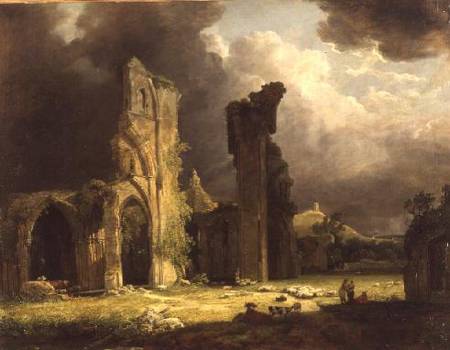
The
Medieval Period
At the Norman Conquest in
1066, the wealth of Glastonbury
made it a prime prize. The new Norman abbot, Turstin,
added to the church, unusually building to the east of the older Saxon church
and away from the ancient cemetery, thus shifting the sanctified site. Not all
the new Normans
were suitable heads of religious communities. In 1077, Thurstin
was dismissed after his armed retainers killed monks
right by the High Altar. In 1086, when Domesday Book
was commissioned, Glastonbury
Abbey was the richest monastery in the country. Abbot Henry of Blois commissioned a history of Glastonbury, about 1125,
from the chronicler William of Malmesbury, whose De Antiquitate Glastoniensis
Ecclesiae is our source for the early recorded history, and much awe-inspiring
legend as well. Then as now, legend worked more strongly than raw history to
bring the pilgrims who sustained the Abbey's reputation and contributed to its
upkeep.
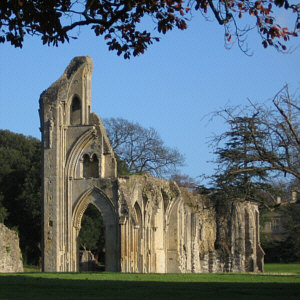
King
Arthur's Grave
Purported site of King Arthur
and Queen Guinevere's tomb beneath the high altar In
1184, a great fire at Glastonbury
destroyed the monastic buildings. Reconstruction began almost immediately and
the Lady Chapel, which includes the well, was consecrated in 1186. There is
evidence that, in the twelfth century, the ruined nave was renovated enough for
services while the great new church was being constructed. If pilgrim visits
had fallen, the discovery of King Arthur and Queen Guinevere's grave in the
cemetery in 1191 provided fresh impetus for visiting Glastonbury.
According to two accounts by the chronicler, Giraldus
Cambrensis,[9] the abbot, Henry
de Sully, commissioned a search, discovering at the depth of 16 feet (5 m) a
massive hollowed oak trunk containing two skeletons. Above it, under the
covering stone, according to Giraldus, was a leaden
cross with the unmistakably specific inscription Hic jacet
sepultus inclitus rex Arthurus in insula Avalonia ("Here lies interred the famous King Arthur
on the Isle of Avalon").
Annexation
to Bath
and Wells
Five years later, in 1197, Savaric FitzGeldewin, bishop of Bath
and Wells, persuaded Pope Celestine III to allow the annexation of Glastonbury
Abbey to his diocese. He officially moved his Episcopal seat there, but the
monks would not accept their new Bishop of Glastonbury
and he was kept away from the abbey.[11] The bishops
continued to use the title Bishop of Bath
and Glastonbury
until finally renouncing their claim to Glastonbury
in 1219. Services in the reconsecrated Great
Church
had begun on Christmas Day, 1213, most likely before it was entirely completed.
King Edward I and Queen Eleanor attended the magnificent service at the
reburial of King Arthur's remains to the foot of the High Altar in 1278.
The
14th Century
In the 14th century, only Westminster
Abbey was more richly endowed and appointed than Glastonbury.
The abbot of Glastonbury kept
great state, now attested to simply by the ruins of the abbot's kitchen, with
four huge fireplaces at its corners. The kitchen was part of the magnificent
Abbot's house begun under Abbot John de Breynton
(1334–42). It is one of the best preserved medieval kitchens in Europe,
and the only substantial monastic building at surviving at Glastonbury.
Archaeological excavations have revealed a special apartment erected at the
south end of the Abbot's house for a visit from Henry VII, who visited the
Abbot in a royal progress, as he visited any other great territorial magnate.
The conditions of life in England
during the Wars of the Roses became so unsettled that a wall was built around
the Abbey's precincts.
Dissolution
of the Monasteries
At the start of the
Dissolution of the Monasteries in 1536, there were over 800 monasteries,
nunneries and friaries in England.
By 1541, there were none. More than 15,000 monks and nuns had been dispersed
and the buildings had been seized by the Crown to be sold off or leased to new
lay occupiers. Glastonbury
Abbey was once more a rich plum. In September 1539, the Abbey was stripped of
its valuables and Abbot Richard Whiting (Whyting),
who had been a signatory to the Act of Supremacy that made Henry VIII the head
of the church, resisted and was hanged, drawn and quartered as a traitor on Glastonbury
Tor on November
15, 1539.
After the Dissolution, two of
the Abbey's manors in Wiltshire were sold by the Crown to John Thynne and thereafter descended in his family, who much later
became Marquesses of Bath.
The Thynnes have preserved many of the Abbey's
Wiltshire records at Longleat up to the present day.
The
Ruins
By Shakespeare's time, two
generations later, Glastonbury
was one of the "bare ruin'd choirs Where late the sweet birds sang."
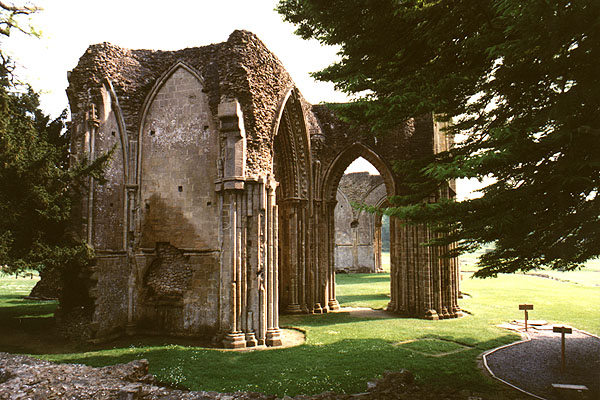
The
Library
One of the earliest surviving manuscripts, now
at the Bodleian Library, telling that Dunstan the
abbot gave orders for the writing of this book.The
Abbey library was described by John Leland, King Henry VIII's
antiquary who visited it, as containing unique copies of ancient histories of
England and unique early Christian documents. It seems to have been affected by
the fire of 1184, but still housed a remarkable collection until 1539 when it
was dispersed at the Dissolution of the Monasteries. Some of the manuscripts
from Glastonbury
have been traced.

The
Modern Era
The ruins of Glastonbury
Abbey were purchased by the Bath
and Wells Diocesan Trust in 1908. The ruins are therefore now the property of
the Church of England. On acquiring the site the Church appointed Frederick
Bligh Bond to direct an archaeological investigation.
A pilgrimage to the ruins of Glastonbury
Abbey was held by a few local churches in 1924. Pilgrimages continue today to be
held; in the second half of June for the Anglicans and early in July for the
Catholics and they attract visitors from all over Western Europe. Services are
celebrated in the Anglican, Roman Catholic and Eastern Orthodox traditions.
The ruins of the great
church, along with the Lady Chapel is a grade I listed building, set in 36
acres (150,000 m2) of parkland and open to the public. It is approached by the
Abbey Gatehouse which was built in the mid 14th century and completely restored
in 1810. The 14th century Abbey Barn is also open to the public, outside the
walls, as part of the Somerset Rural Life Museum.
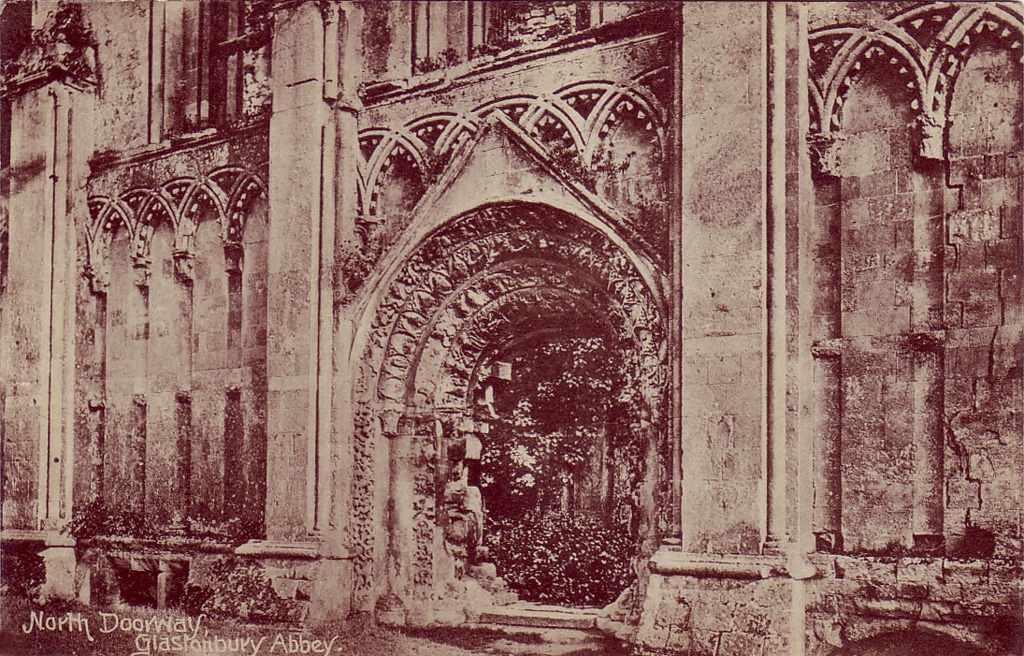
The Theosophy Cardiff
Glastonbury
Pages
Chalice Well, Glastonbury.
The Theosophy Cardiff Guide to
Chalice Well, Glastonbury,
Somerset, England
The Theosophy Cardiff Guide to
Glastonbury Abbey
Theosophy Cardiff’s
Glastonbury Abbey Chronology
The Theosophy Cardiff Guide to
Glastonbury Tor
The Labyrinth
The Terraced Maze of Glastonbury Tor
Glastonbury and
Joseph of Arimathea
The Grave of King Arthur & Guinevere
At Glastonbury Abbey
Views of Glastonbury High Street
The Theosophy Cardiff Guide to
Glastonbury Bookshops
_____________________

_____________________________
Theosophy
Links
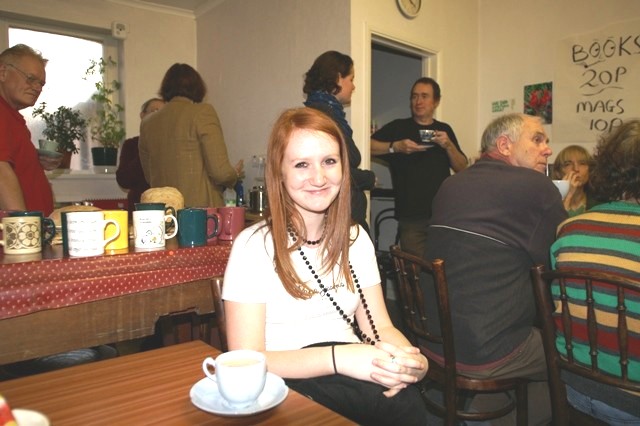
Cardiff Theosophical
Society meetings are informal
and there’s always a cup of tea afterwards
Theosophy
Cardiff
The
Cardiff Theosophical Society Website
Theosophy
Wales
The
National Wales Theosophy Website
Links
to groups in
Bangor,
Cardiff, Conwy & Swansea
Cardiff
Blavatsky Archive
Life
& Work of H P Blavatsky
A
Theosophy Study Resource
Dave’s
Streetwise
Theosophy
Boards
The
Theosophy Website that
Welcomes
Absolute Beginners
If you
run a Theosophy Group, please feel free
to use any of the
material on this site
Theosophy Cardiff’s Instant Guide
to Theosophy
Cardiff Theosophy Start-Up
A Free Intro to Theosophy
Theosophy Cardiff Burn-Up
Theosophy Wales Burn-Up
Cardiff Theosophical Archive
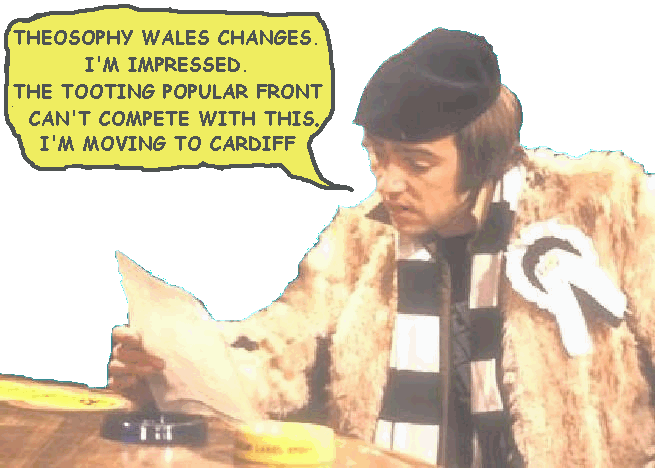
Theosophy Wales 2008 Changes
A new structure for the
Theosophical Movement in Wales
as
it separates into independent
groups that run do their own show
Blavatsky Blogger
Independent
Theosophy Blog
Quick Blasts of Theosophy
One liners and quick explanations
About aspects of Theosophy
Great Theosophists
The
Big Names of Theosophy
H P
Blavatsky is usually the only
Theosophist
that most people have ever
heard of. Let’s
put that right
The Blavatsky Blogger’s
Instant Guide To
Death & The Afterlife
Blavatsky
Calling
The
Voice of the Silence Website
The
Blavatsky Free State
An
Independent Theosophical Republic
Links
to Free Online Theosophy
Study
Resources; Courses, Writings,
Commentaries,
Forums, Blogs
Feelgood
Theosophy
Visit the Feelgood Lodge
The main criteria for the inclusion of
links on this site is that they have some
relationship (however tenuous) to Theosophy
and are lightweight, amusing or entertaining.
Topics include Quantum Theory and Socks,
Dick Dastardly and Legendary Blues
Singers.
Theosophy and Reincarnation
A selection of articles on Reincarnation
by
Theosophical writers
Provided in response to the large
number of enquiries we receive at
Cardiff Theosophical Society on this subject
Nothing answers questions
like Theosophy can!
The Key to Theosophy
Applied Theosophy
Henry Steel Olcott
Blavatsky
Calling
and I Don’t Wanna Shout
The
Voice of the Silence Website
Theosophy Wales
Vanguard
The
South of Heaven Guide
To
Theosophy and Devachan
The South of Heaven Guide
To Theosophy and Dreams
The South of Heaven Guide
To Theosophy and Angels
Theosophy and Help From
The Universe
Hey
Look!
Theosophy
in Wales
Wales!
Wales! Theosophy Wales
The All
Wales Guide to
Getting
Started in Theosophy
This is for
everyone, you don’t have to live
in Wales to make
good use of this Website
Hey Look!
Theosophy
in Cardiff
Theosophy
in Wales
The Grand Tour
Theosophy Avalon
The
Theosophy Wales
King
Arthur Pages
Theosophy
Nirvana
Theosophy Wales
Theosophy
Ernest Egerton Wood
Theosophy
Jinarajadasa
Theosophy
Starts Here
Theosophy
Aardvark
No
Aardvarks were harmed in the
preparation of
this Website
Theosophy
Aardvark
Heavy Metal Overview
Theosophy
Aardvark
Rock ‘n Roll Chronology
Theosophy in the UK
Within the British Isles, The
Adyar Based Theosophical Society is the largest
Single Theosophical body and has Groups in;
Bangor*Basingstoke*Billericay*Birmingham*Blackburn*Bolton*Bournemouth
Bradford*Bristol*Camberley*Cardiff*Chester*Conwy*Coventry*Dundee*Edinburgh
Folkstone*Glasgow*Grimsby*Inverness*Isle
of Man*Lancaster*Leeds*Leicester
Letchworth*London*Manchester*Merseyside*Middlesborough*Newcastle upon Tyne
North Devon*Northampton*Northern Ireland*Norwich*Nottingham
Perth*Republic of Ireland*Sidmouth*Southport*Sussex*Swansea*Torbay
Tunbridge Wells*Wallasey*Warrington*Wembley*Winchester*Worthing
The Tooting Broadway
Underground Theosophy Website
The Spiritual Home of Urban Theosophy
The Mornington Crescent
Underground Theosophy Website
The Earth Base for Evolutionary Theosophy
_____________________
Tekels Park
Concerns about the fate of the
wildlife as
Tekels Park is to be Sold to a
Developer
Concerns are raised about the fate of
the wildlife as
The Spiritual Retreat, Tekels Park in
Camberley,
Surrey, England is to be sold to a
developer.
Tekels Park is a 50 acre woodland
park, purchased
for the Adyar
Theosophical Society in England in 1929.
In addition to concern about the
park, many are
worried about the
future of the Tekels Park Deer
as they are not a
protected species.
Anyone planning a “Spiritual” stay at
the
Tekels Park Guest House should be
aware of the sale.
Diploma in Finance ?
It doesn’t require a Diploma in Finance
and even someone
with a Diploma in
Astral Travel will know that this is a
bad time
economically to sell Tekels Park
Future
of Tekels Park Badgers in Doubt
____________________
H
P Blavatsky’s Heavy Duty
Theosophical
Glossary
Published
1892
A
B
C
D
EFG
H
IJ
KL
M
N
OP
QR
S
T
UV
WXYZ
Complete Theosophical Glossary in Plain Text Format
1.22MB
Instant
Guide to Theosophy
Quick
Explanations with Links to More Detailed Info
What is Theosophy ? Theosophy Defined (More Detail)
Three Fundamental Propositions Key Concepts of Theosophy
Cosmogenesis
Anthropogenesis
Root Races
Karma
Ascended Masters After Death States
Reincarnation
The Seven Principles of Man Helena Petrovna Blavatsky
Colonel Henry Steel Olcott William Quan Judge
The Start of the Theosophical Society
History of the Theosophical Society
Theosophical Society Presidents
History of the Theosophical Society in Wales
The Three Objectives of the Theosophical Society
Explanation of the Theosophical Society Emblem
Glossaries of Theosophical Terms
Elementary Theosophy
An Outstanding Introduction to Theosophy
By a student of Katherine Tingley
Elementary Theosophy Who is the Man? Body and Soul
Body, Soul and Spirit Reincarnation Karma
The Seven in Man and Nature
The Meaning of Death
A Text Book of Theosophy
Charles Webster Leadbeater
What Theosophy Is From the Absolute to Man
The Formation of a Solar System The Evolution of Life
The Constitution of Man After Death Reincarnation
The Purpose of Life The Planetary Chains
The Result of Theosophical Study
An Outline of Theosophy
Charles Webster Leadbeater
Theosophy - What it is How is it Known? The Method of Observation
General Principles The Three Great Truths The Deity
Advantage Gained from this
Knowledge The Divine Scheme
The Constitution of Man The True Man Reincarnation
The Wider Outlook Death Man’s Past and Future
Cause and Effect What Theosophy does for us
Try these if you are looking
for a local
Theosophy Group or Centre
UK Listing of Theosophical Groups
Please tell us about your UK Theosophy Group
Worldwide Directory of
Theosophical Links
International Directory of
Theosophical Societies
___________________
SearchSight
DMOZ Open Directory Project
Theosophy Links
Link Exchange Web &
Blog Directory of Top Sites Dmegs.com
SEO friendly web directory of top sites & blogs organized by topic
into categories and presented according to relevance of
website.
Submit your website
free.
Web Directory
- Add Link - Submit Article - Online Store - Forum
The So Much Directory
http://www.somuch.com
______________________
WALES
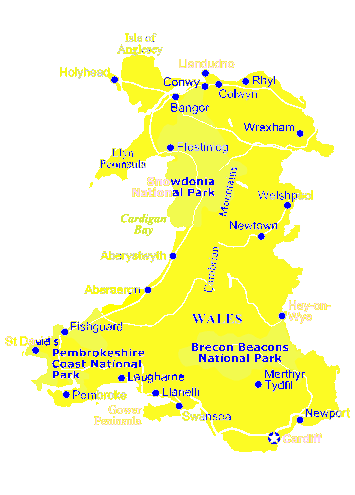
Pages about Wales
General pages about Wales, Welsh History
and The History of Theosophy in Wales
Wales is a
Principality within the United Kingdom and has an eastern
border with England. The
land area is just over 8,000 square miles.
Snowdon in North Wales is
the highest mountain at 3,650 feet.
The coastline is
almost 750 miles long. The population of Wales
as at the 2001 census
is 2,946,200.
________________
Hey Look!
Theosophy in Cardiff
Theosophy Wales
Theosophy UK

Bangor Conwy
& Swansea Lodges are members
of the Welsh
Regional Association (Formed 1993).
Theosophy Cardiff separated from the
Welsh Regional
Association in March 2008 and became an independent
body within the
Theosophical Movement in March 2010
High
Drama & Worldwide Confusion
as Theosophy
Cardiff Separates from the
Welsh
Regional Association (formed 1993)
Theosophy Cardiff cancels its Affiliation
to
the Adyar Based Theosophical Society
theosophycardiff.org
Theosophy Cardiff
Theosophy House
206 Newport Road,
Cardiff, Wales,
UK, CF24 – 1DL











